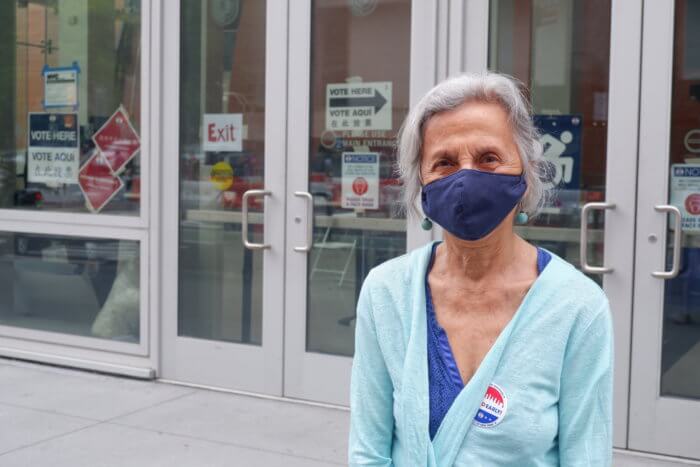New York City voters came out to cast their ballots for the city’s next mayor and many other local elected offices during the first weekend of early voting.
In Red Hook, Brooklyn, local Bridgette Defreitas was among a trickle of voters at the poll site inside the Red Hook Recreation Center on Bay Street Sunday morning.
“If you don’t vote and exercise that right, then how do you get what you need done in your community, or just in general in the city” Defreitas told Brooklyn Paper’s sister publication amNewYork Metro. “In the height of the pandemic, I voted.”
As a New York City Housing Authority resident, Defreitas’s major issues include the upkeep of the city’s public housing stock, crime, and having a person of color such as herself in office, which led her to rank Brooklyn Borough President Eric Adams as first choice for mayor.
She still prefers to vote in person, despite the city’s Board of Elections allowing all registered voters to mail in absentee ballots during the COVID-19 pandemic.
“Mail-in ballot is ok, but for me, in person I get to see and make those choices,” she said. “I just like in-person, it’s important to me that I be here.”
Another Red Hook resident said he ranked civil rights attorney Maya Wiley first for mayor, followed by former Sanitation Commissioner Kathryn Garcia, saying Wiley’s recent endorsement by progressive Congresswoman Alexandria Ocasio-Cortez (D–Bronx/Queens) cemented his support for the former advisor to Mayor Bill de Blasio.
“The AOC endorsement of Maya Wiley pushed her number one for me,” said Gabe Salzer, who said his biggest issues were housing, education, and climate change.

Early voting for this year’s primaries started on June 12 and runs through June 20, followed by Election Day on Tuesday, June 22. Up for a vote are the city’s mayor, comptroller, public advocate, borough presidents, most of the city council seats, the Manhattan District Attorney, and several judges.
With most of the city covered in solidly-blue districts, the contests will be largely decided in the Democratic primaries.
The New York City Board of Elections clocked a turnout of 16,867 check-ins at voting sites on Saturday, the first day of early voting — a low number compared to the first day of early voting for the 2020 Presidential election last fall, when almost 94,000 came out to vote.
City and state election cycles tend to draw far fewer voters with the 2017 mayoral race yielding a 21.5 percent turnout, compared to roughly 53.4 percent who voted for president in 2020.
It is also the first citywide election using ranked choice voting, which allows people to rank up to five candidates for municipal elections. City voters adopted the new system by referendum in 2019 with an overwhelming majority of 73.5 percent.

At a poll site at New York City College of Technology in Downtown Brooklyn, the ranked voting debut received mixed reactions.
“That is cool,” said Michael Bradshaw, an Adams voter, of ranked choice voting. “It’s easier, it’s a simple situation.”
One Cobble Hill resident said she supports the change, but worried that it might confuse some voters, especially with the myriad of people running for less-prominent elected offices.
“It might be kind of intimidating for a lot of people, especially [voting] for councilmembers that we know very little about,” said Simona McCray, who ranked Garcia as her first choice, followed by city Comptroller Scott Stringer. “I believe in ranked voting but there could be a lot of errors when you’re filling them out, you could get confused.”
A Brooklyn Heights man liked the large choice of candidates to pick from, but added that the city should have stuck with the old system.
“One vote, one person, one candidate,” said Arthur Fisch, who was about to cast a ballot for Adams. “I think it’s absurd, I think it’s totally stupid and I don’t know if anybody knows how it’s going to work and I think the way the other way worked, we should keep it.”

While many voters had different opinions on who should run the city over the coming four years, everyone amNewYork Metro spoke to agreed on one thing: vote!
“We need to make good educated choices about who we’re voting for, why we’re voting for them and hopefully in return they will work for us,” said Defreitas.
This story first appeared on AMNY.com.























